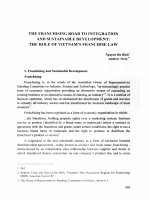The role of advertising in society
Bạn đang xem bản rút gọn của tài liệu. Xem và tải ngay bản đầy đủ của tài liệu tại đây (226.86 KB, 27 trang )
Ministry of education and training
Ha noi foreign trade university
The role of advertising in society
Student : dong thi thu hang.
Class : A11-K38D
Instructor : MBA le thi hai.
Ha Noi 9/2002
Index
Introduction
Part I : General knowledge of advertising
1. Some typical concepts of advertising
2. Classifications of advertising
Part II : The role of advertising in society
1. Economic effects of advertising
a. On governments
b. On citizens
c. On businesses
2. Social effects
a. Good effects
b. Bad ones
Part III : The role of Vietnam’s advertising industry in the
economy
1. Present situation and contributions of Vietnam’s advertising
industry
2. The changing responses of Vietnamese towards advertising.
Conclusion
2
Introduction
Entering the 21
st
century, integrating the market mechanism,
enterprises have to accept competition and be compatible with the circulation
of economic regulations in the economy. One of the keys for firms to reach
these goals is advertising. The more feasible one company’s advertising
campaign is, the less risks in business it has, the more profits it gains and the
more it breaks into market.
Advertising is instrumental in sales promotion, which is one of the
most vital tools in Marketing. The appearance and the role of advertising is
increasingly higher in the market economy. Advertising shows the rapid
growth in technology and lifestyle, in people’s tastes and consumption.
Advertising has become an important part of economic development
process not only in one country but also in the world. In Vietnam,
advertising activities have just become effervescent. It has contributed much
to the country’s renovation, to the growth of production, to the enrichment of
people’s knowledge and needs to goods, which makes it develop the
country’s human resources effectively. Moreover, advertising also plays an
important role in promoting and developing the cooperation between
Vietnam and other countries in trade and technology.
Along with the deep and wide development of international and
domestic relationships, Vietnam advertising industry has rapidly developed
with more and more various types though it still faces with many difficulties
and law on advertising has not been fixed. Therefore, the government should
pay more attention to this “no smoking” industry.
With the limited knowledge and materials on advertising, I myself try
to give out an overview of advertising and its role in economy, of which
mistakes and shortcomings are not avoidable. I give my strong
acknowledgement to MBA LE THI HAI and Mr PHAM GIA TRI , Mr
NGUYEN HUYEN MINH who all supported me much during finishing this
thesis.
3
Part I : General knowledge of advertising
1. Some typical concepts of advertising.
Advertising is any of indirect appearance of goods, services or ideas which
we have to pay for to recognise the advertisers ( according to American
Marketing Association – AMA ).
Advertising involves widely introducing about firms, goods, services,
brandnames and symbols according to the operational aimes of companies
( according to the decree No 194/ CP issued 21/12/94 )
Advertising is used to promote consumers’ tastes, introduce new
goods and improve the people’s consuming habit ( according to the
dictionary of scientific and technical publisher – 1990 ).
2. Classifications of advertising
a. Advertising to the consumer market
a1. National advertising.
Advertising done by a company on a nationwide basis or in most
regions of the country and targeted to the ultimate consumer market is
known as national advertising. The companies that sponsor these ads are
generally referred to as national advertisers. Most of the ads for well-known
brands that we see on prime-time TV or in other major national or regional
media are examples of national advertising. This form of advertising is
usually very general; it rarely includes specific prices, directions for buying
the product, or services associated with the purchase. It informs or reminds
consumers of the brand and its features, benefits, advantages, and uses or
reinforces its image so consumers will be predisposed to purchase it.
National advertising is the best known and most widely discussed form of
promotion, probably because of its pervasiveness.
a2. Retail/local advertising
Another prevalent type of advertising directed at the consumer market
is classified as retail/local advertising. This type of advertising is done by
major retailers or smaller local merchants to encourage consumers to shop at
a specific store or use a local service such as a bank, fitness club, or
restaurant.
While the national advertisers sell their products at many locations,
retail or local advertisers must give the consumer a reason to patronize their
establishments. Retail advertising tends to emphasize specific customer
benefits such as store hours, credit policies, service, atmosphere, merchandise
assortments, or other distinguishing attributes. Product availability and price
are important advertising themes, often used in conjunction with a sale or
special event. Retailers are concerned with building store traffic, and often
4
their promotions take the form of direct-action advertising designed to produce
immediate store traffic or sales.
In addition to their product- and price-oriented advertising, many
retailers use image advertising to influence consumers perceptions of their
stores.
a3. Direct-response advertising
One of the fastest-growing sectors in developed countries is direct
marketing. Direct response advertising is a method of marketing whereby a
product is promoted through an ad that lets the customer purchase directly
from the manufacturer. Traditionally, direct mail has been the primary
medium for direct-response advertising, although television is becoming an
increasingly important medium.
Direct-response advertising has become very popular in recent years
owing primarily to changing lifestyles, particularly the increase in two-
income households. This has meant more discretionary income but less time
for in-store shopping. The convenience of shopping through the mail or by
telephone has led to the tremendous increase in direct-response advertising.
Credit cards and toll-free telephone numbers have also facilitated the
purchase of products from direct-response advertisements.
a4. Primary and selective demand advertising
Another way of viewing advertising to the ultimate customer is in
terms of whether the message is designed to stimulate either primary or
selective demand. Primary demand advertising is designed to stimulate
demand for the general product class or entire industry; selective demand
advertising focuses on creating demand for a particular manufacturer's
brands. Most advertising for various products and services is concerned with
stimulating selective demand and emphasizes reasons for buying a particular
brand. Advertisers generally assume there is a favorable level of primary
demand for the product class and focus attention on increasing their market
share. Thus, their advertising attempts to give consumers a reason to buy
their brand.
Advertisers might concentrate on stimulating primary demand in
several situations. When a company's brand dominates a market, it may
focus on creating demand for the product class, since it will benefit the most
from market growth. For example, Pepsi Cola has over 70 percent of the soft
drink market, and the company's advertising objective is to encourage
consumers to drink more. Primary demand advertising is often used as part
of a promotional strategy to help a new product gain acceptance among
customers. Products in the introductory or growth stages of their life cycles
often have primary demand stimulation as a promotional objective because
5
the challenge is to sell customers on the product as much as it is to sell a
particular brand.
b. business-to-business advertising
For many companies, the ultimate customer is not the mass consumer
market but rather another business, industry, or profession. Business-to-
business advertising is used by one business to advertise its products or
services to another. The target for business advertising is individuals who
either use a product or service or influence a firm's decision to purchase a
product or service. Two basic categories of business-to-business advertising
are industrial and professional advertising
b.1. Industrial advertising
Advertising targeted at individuals who buy or influence the purchase
of industrial goods or other services is known as industrial advertising.
Industrial goods are those products that either become a physical part of
another product (raw material, component parts), are used in manufacturing
other goods (machinery, equipment), or are used to help the manufacturer
conduct business (office supplies, computers, copy machines, etc.). Business
services, such as insurance, financial services, and health care, are also
included in this category.
Industrial advertising is usually found in general business publications
or in trade publications targeted to the particular industry. In recent years,
ads for industrial products and services have become more common in mass
media such as television.
Industrial advertising is often not designed to sell a product or service
directly, since the purchase of industrial goods is often a complex process
involving a number of individuals. An industrial ad helps make the company
and it product or service better known, assists in developing an image for the
firm, and perhaps most important, opens doors for the company's sales reps
when they call on industrial customers.
b.2. Professional advertising
Advertising that is targeted to professional groups-such as doctors,
lawyers, dentists, engineers, or professors-to encourage them to use the
advertisers’ product or specify it for others to use is known as professional
advertising. Professional groups are important because they constitute a
market for products and services they use in their businesses. Also, their
recommendation or specification of a product or service often influences
many consumer purchase decisions. For example, Colgate initially targeted
advertising for Colgate plaque-fighting toothpaste and oral rinse to dentists
to encourage them to recommend these products to their patients.
Professional advertising should not be confused with advertising done by
professionals. In recent years, advertising by professionals such as dentists,
6
lawyers, and doctors has increased in popularity as legal restrictions were
removed and competition increased.
These classifications of the various types of advertising demonstrate
that this promotional element is used in a variety of ways and by a number of
different organizations. Advertising is a very flexible promotional tool
whose role in a marketing program will vary depending on the situation
facing the organization and what information needs to be communicated.
7
Part II : the role of advertising in society
1. Economic effects of advertising.
Advertising plays an important role in a free market system by making
consumers aware of products and services and providing them with
information for decision making.
Advertising can encourage consumption and foster economic growth.
It not only informs customers of available goods and services but also
facilitates entry into markets for a firm or a new product or brand; leads to
economies of scale in production, marketing, and distribution, which in turn
lead to lower prices; and accelerates the acceptance of new products and
hastens the rejection of inferior products.
a. Effects on citizens
a.1. To the consumer choice.
Some people say advertising hampers consumer choice, as large
advertisers use their power to limit our options to a few well-advertised
brands. They argue that advertising is used to achieve (1) differentiation,
whereby the products or services of large advertisers are perceived as unique
or better than competitors', and (2) brand loyalty, which enables large
national advertisers to gain control of the market, usually at the expense of
smaller brands.
Larger companies often end up charging a higher price and achieve a
more dominant position in the market than smaller firms that cannot compete
against them and their large advertising budgets. When this occurs,
advertising not only restricts the choice alternatives to a few well-known,
heavily advertised brands but also becomes a substitute for competition
based on price or product improvements.
Heavily advertised brands dominate the market in certain product
categories, such as soft drinks, beer, and cereals. However, advertising
generally does not create brand monopolies and reduce the opportunities for
new products to be introduced to consumers. In most product categories, a
number of different brands are on the store shelves and thousands of new
products are introduced every year. The opportunity to advertise new brands
gives companies the incentive to develop new brands and improve their
existing ones. When a successful new product such as a personal computer is
introduced, competitors quickly follow and use advertising to inform
consumers about their brand and attempt to convince them it is superior to the
original.
Many critics claim advertising has an adverse effect on consumer
values by encouraging materialism, a preoccupation with material things
rather than intellectual or spiritual concerns. The United States is
8
undoubtedly the most materialistic society in the world, which many critics
attribute to advertising that.
Seeks to create needs rather than merely showing how a product or
service fulfills them. Surrounds consumers with images of the good life and
suggests the acquisition of material possessions leads to contentment and
happiness and adds to the joy of living. Suggests material possessions are
symbols of status, success, and accomplishment and/or will lead to greater
social acceptance, popularity, sexual appeal, and so on.
The criticism of advertising on the grounds that it encourages
materialistic values assumes that materialism is undesirable and is sought at
the expense of other goals. Many believe materialism is an acceptable part of
the Protestant ethic, which stresses hard work and individual effort and
initiative and views the accumulation of material possessions as evidence of
success. Others argue that the acquisition of material possessions has
positive economic impact by encouraging consumers to keep consuming
after their basic needs are met. Many Americans believe economic growth is
essential and materialism is both a necessity and an inevitable part of this
progress.
A famous economist describes the role advertising plays in
industrialized economies by encouraging consumption:
Advertising and its related arts thus help develop the kind of man the
goals of the industrial system require-one that reliably spends his income and
works reliably because he is always in need of more...In the absence of the
massive and artful persuasion that accompanies the management of demand,
increasing abundance might well have reduced the interest of people in
acquiring more goods...Being not pressed by the need for these things, they
would have spent less reliably to get more. The consequence-a lower and
less reliable propensity to consume-would have been awkward for the
industrial system.
It has also been argued that an emphasis on material possessions does
not rule out interest in intellectual, spiritual, or cultural values. Defenders of
advertising say consumers can be more interested in higher-order goals when
basic needs have been met. They point out that consumers may purchase
material things in the pursuit of nonmaterial goals. For example, a person
may buy an expensive stereo system to enjoy music rather than simply to
impress someone or acquire a material possession.
Even if we assume materialism is undesirable, there is still the
question of whether advertising is responsible for creating and encouraging
it. While many critics argue that advertising is a major contributing force to
materialistic values, others say advertising merely reflects the values of
society rather than shaping them. They argue that consumers' values are
defined by the society in which they live and are the results of extensive,
long-term socialization or acculturation.
Advertising does contribute to our materialism by portraying products
and services as symbols of status, success, and achievement and by
9
encouraging consumption. As one said, "While it may be true that
advertising reflects cultural values, it does so on a very selective basis,
echoing and reinforcing certain attitudes, behaviors, and values far more
frequently than others."
The extent to which advertising is responsible for materialism and the
desirability of such values are deep philosophical issues that will continue to
be part of the debate over the societal value and consequences of advertising.
Furthermore, a common criticism of advertising is that it manipulates
consumers into buying things they do not need. Many critics say advertising
should just provide information useful in making purchase decisions and
should not persuade. They view information advertising, which reports price,
performance, and other objective criteria as desirable. Persuasive advertising,
however, which plays on consumers' emotions, anxieties, and psychological
needs and desires such as status, self-esteem, and attractiveness, is viewed as
unacceptable. Persuasive advertising is criticized for fostering discontent
among consumers and encouraging them to purchase products and services
to solve deeper problems.
Critics say advertising exploits consumers and persuades them to
buy things they don't need. Defenders of advertising offer a number of
rebuttals to these criticisms. First, they point out that a substantial amount
of advertising is essentially informational in nature. Also, it is difficult to
separate desirable informational advertising from undesirable persuasive
advertising.
If advertising critics really believe that persuasive advertising should
not be permitted, they are actually proposing that no advertising be allowed,
since the purpose of all advertising is to persuade. Defenders of advertising
also take issue with the argument that it should limit itself to dealing with
basic functional needs. In our society, most lower-level needs recognized in
Maslow's hierarchy, such as the need for food, clothing, and shelter, are
satisfied. It is natural for people to move from basic needs to higher-order
ones such as self-esteem and status or self-actualization. Consumers are free
to choose the degree to which they attempt to satisfy their desires, and wise
advertisers associate their products and services with the satisfaction of
higher-order needs.
Proponents of advertising offer two other defenses against the charge
that advertising makes people buy things they do not really need. First, this
criticism attributes too much power to advertising and assumes consumers
have no ability to defend themselves against advertising.
Second, it ignores the fact that consumers have the freedom to make
their own choices when confronted with persuasive advertising. While they
readily admit the persuasive intent of their business, advertisers are quick to
10









